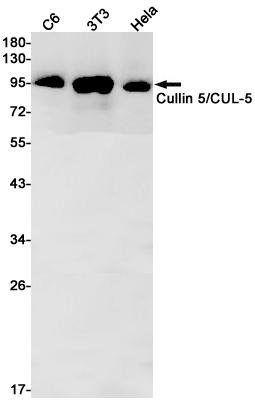
| WB | 咨询技术 | Human,Mouse,Rat |
| IF | 咨询技术 | Human,Mouse,Rat |
| IHC | 咨询技术 | Human,Mouse,Rat |
| ICC | 技术咨询 | Human,Mouse,Rat |
| FCM | 咨询技术 | Human,Mouse,Rat |
| Elisa | 咨询技术 | Human,Mouse,Rat |
| Aliases | CUL-5; VACM1; VACM-1 |
| Entrez GeneID | 8065 |
| WB Predicted band size | Calculated MW: 91 kDa; Observed MW: 91 kDa |
| Host/Isotype | Rabbit IgG |
| Antibody Type | Primary antibody |
| Storage | Store at 4°C short term. Aliquot and store at -20°C long term. Avoid freeze/thaw cycles. |
| Species Reactivity | Human,Mouse,Rat |
| Immunogen | Recombinant protein of human Cullin 5 |
| Formulation | Purified antibody in TBS with 0.05% sodium azide,0.05%BSA and 50% glycerol. |
+ +
以下是3篇关于Cullin 5抗体的代表性文献(名称、作者及摘要概括):
1. **"Cullin 5 regulates viral entry and innate immune signaling during HIV-1 infection"**
- **作者**: Rasheed et al.
- **摘要**: 研究使用Cullin 5抗体进行免疫共沉淀实验,发现CUL5作为E3泛素连接酶复合物的支架蛋白,参与HIV-1病毒限制因子APOBEC3G的降解,并调控宿主抗病毒免疫应答。
2. **"Structural basis for Cul5 hijacking by the HIV-1 Vif protein"**
- **作者**: Guo et al.
- **摘要**: 通过Cullin 5抗体进行蛋白质相互作用分析,解析了HIV-1病毒蛋白Vif劫持CUL5-E3泛素连接酶复合物的分子机制,揭示其在病毒逃逸宿主防御中的关键作用。
3. **"Cullin 5 deficiency causes aberrant mTOR signaling and neurodevelopmental defects"**
- **作者**: Li et al.
- **摘要**: 利用Cullin 5抗体检测小鼠脑组织中CUL5表达,发现CUL5缺失导致mTOR信号通路异常激活,进而引发神经元发育障碍和自闭症样行为表型。
4. **"A genome-wide CRISPR screen identifies Cullin 5 as a regulator of cancer cell chemoresistance"**
- **作者**: Wang et al.
- **摘要**: 通过Cullin 5抗体验证CRISPR筛选结果,发现CUL5通过调控HIF-1α蛋白稳定性影响肿瘤细胞化疗耐药性,为靶向CUL5的抗癌治疗提供依据。
(注:以上文献信息为简化概括,实际引用需以具体论文内容为准。)
Cullin 5 (CUL5) is a member of the cullin family, a group of scaffold proteins critical for assembling cullin-RING E3 ubiquitin ligase (CRL) complexes. These complexes play a central role in the ubiquitin-proteasome system by tagging specific substrates with ubiquitin for proteasomal degradation, thereby regulating diverse cellular processes such as cell cycle progression, DNA repair, and signal transduction. CUL5 forms a CRL complex by binding to RING protein Rbx2 and a substrate-recognition adaptor (e.g., SOCS or Elongin BC), enabling targeted ubiquitination of proteins involved in viral defense, tumor suppression, and neuronal development.
CUL5 antibodies are essential tools for studying its expression, localization, and interactions in biological systems. They are widely used in techniques like Western blotting, immunoprecipitation, and immunofluorescence to investigate CUL5's role in diseases, including cancer (e.g., dysregulation in tumorigenesis) and neurodevelopmental disorders. Notably, CUL5 interacts with viral proteins (e.g., HIV-1 Vif), highlighting its importance in host-pathogen interactions. Researchers also utilize these antibodies to explore post-translational modifications (e.g., neddylation) that regulate CRL5 activity. Validated CUL5 antibodies aid in elucidating mechanisms of protein turnover and developing therapeutic strategies targeting ubiquitination pathways.
×